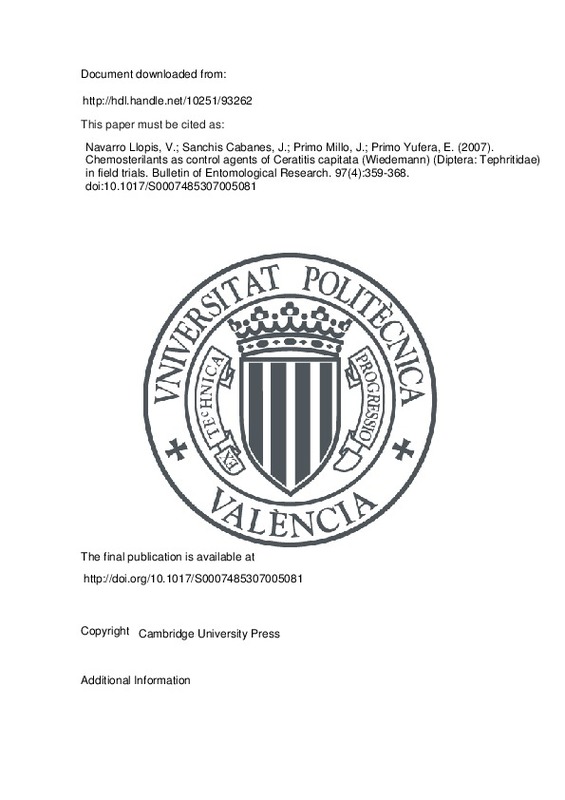JavaScript is disabled for your browser. Some features of this site may not work without it.
Buscar en RiuNet
Listar
Mi cuenta
Estadísticas
Ayuda RiuNet
Admin. UPV
Chemosterilants as control agents of Ceratitis capitata (Wiedemann) (Diptera: Tephritidae) in field trials
Mostrar el registro sencillo del ítem
Ficheros en el ítem
| dc.contributor.author | Navarro Llopis, Vicente
|
es_ES |
| dc.contributor.author | Sanchis Cabanes, Juan
|
es_ES |
| dc.contributor.author | Primo Millo, Jaime
|
es_ES |
| dc.contributor.author | Primo Yufera, Eduardo
|
es_ES |
| dc.date.accessioned | 2017-12-21T11:31:58Z | |
| dc.date.available | 2017-12-21T11:31:58Z | |
| dc.date.issued | 2007 | es_ES |
| dc.identifier.issn | 0007-4853 | es_ES |
| dc.identifier.uri | http://hdl.handle.net/10251/93262 | |
| dc.description.abstract | [EN] Lufenuron is a chitin synthesis inhibitor, which is able to impede Mediterranean fruit fly, Ceratitis capitata (Wiedemann), reproduction. In laboratory trials, following ingestion of lufenuron, the eggs laid by female Ceratitis capitata were prevented from hatching. In field trials in Valencia, Spain, lufenuron showed its effectiveness by reducing C. capitata wild populations and its continuous application to several generations of fruit fly resulted in increased pest control. This field trial was conducted in an isolated valley some 80ha in size, over a continuous four-year period. In order to maintain the sterilizing effect in the field throughout the whole year, a new lufenuron bait gel was developed. This bait gel was introduced in to delta traps suspended in trees at a density of 24 traps ha 1, and these traps were replaced once a year during the field trial. Monitoring of the adult C. capitata population was conducted to assess the effects of the chemosterilant treatment. In the first year of treatment with sterilizing traps, a reduction of the C. capitata population was observed, indicating that the traps reduce the population right from the first generation. In the second, third and fourth years, a continuous and progressive reduction of the adult Mediterranean fruit fly population was observed. Therefore, the successive application of chemosterilization treatment has a cumulative effect on reducing the fly population year after year. Aerial treatment using malathion does not produce this cumulative effect, and consequently every year it is necessary to start again with the same number of flies as the year before. The possibility of using the chemosterilant method alone or combined with the sterile insect technique is discussed. | es_ES |
| dc.description.sponsorship | The authors thank Stephen Skillman for helpful suggestions on the first version of the manuscript, Syngenta for supplying technical grade lufenuron, and the R&D+i Linguistic Assistance Office at the Universidad Politécnica de Valencia for their help in revising and correcting this paper. This research has been supported by ‘Fundación José y Ana Royo’, ‘Conselleria d’Agricultura Peixca i Alimentacio-GVA’ and INIA project number RTA03-103-C6. | |
| dc.language | Inglés | es_ES |
| dc.publisher | Cambridge University Press | es_ES |
| dc.relation.ispartof | Bulletin of Entomological Research | es_ES |
| dc.rights | Reserva de todos los derechos | es_ES |
| dc.subject | Chemosterilization | es_ES |
| dc.subject | lufenuron | es_ES |
| dc.subject | Ceratitis capitata | es_ES |
| dc.subject | Field trial | es_ES |
| dc.subject | Insect growth regulators | es_ES |
| dc.subject | Mediterranean fruit fly | es_ES |
| dc.subject.classification | BIOQUIMICA Y BIOLOGIA MOLECULAR | es_ES |
| dc.subject.classification | QUIMICA ORGANICA | es_ES |
| dc.title | Chemosterilants as control agents of Ceratitis capitata (Wiedemann) (Diptera: Tephritidae) in field trials | es_ES |
| dc.type | Artículo | es_ES |
| dc.identifier.doi | 10.1017/S0007485307005081 | es_ES |
| dc.relation.projectID | info:eu-repo/grantAgreement/MEC//RTA03-103-C6-3/ES/La mosca de la fruta Ceratitis capitata (Wiedemann) (Diptera:Tephritidae) en parcelas de cítricos dinámica de sus poblaciones y control mediante trampeo masivo. | es_ES |
| dc.rights.accessRights | Abierto | es_ES |
| dc.contributor.affiliation | Universitat Politècnica de València. Instituto Agroforestal Mediterráneo - Institut Agroforestal Mediterrani | es_ES |
| dc.contributor.affiliation | Universitat Politècnica de València. Departamento de Biotecnología - Departament de Biotecnologia | es_ES |
| dc.contributor.affiliation | Universitat Politècnica de València. Departamento de Química - Departament de Química | es_ES |
| dc.description.bibliographicCitation | Navarro Llopis, V.; Sanchis Cabanes, J.; Primo Millo, J.; Primo Yufera, E. (2007). Chemosterilants as control agents of Ceratitis capitata (Wiedemann) (Diptera: Tephritidae) in field trials. Bulletin of Entomological Research. 97(4):359-368. https://doi.org/10.1017/S0007485307005081 | es_ES |
| dc.description.accrualMethod | S | es_ES |
| dc.relation.publisherversion | http://doi.org/10.1017/S0007485307005081 | es_ES |
| dc.description.upvformatpinicio | 359 | es_ES |
| dc.description.upvformatpfin | 368 | es_ES |
| dc.type.version | info:eu-repo/semantics/publishedVersion | es_ES |
| dc.description.volume | 97 | es_ES |
| dc.description.issue | 4 | es_ES |
| dc.identifier.pmid | 17645817 | |
| dc.relation.pasarela | S\31320 | es_ES |
| dc.contributor.funder | Instituto Nacional de Investigaciones Agrarias | es_ES |
| dc.contributor.funder | Ministerio de Educación y Ciencia | |
| dc.contributor.funder | Generalitat Valenciana | |
| dc.contributor.funder | Instituto Nacional de Investigación y Tecnología Agraria y Alimentaria | es_ES |







![[Cerrado]](/themes/UPV/images/candado.png)

